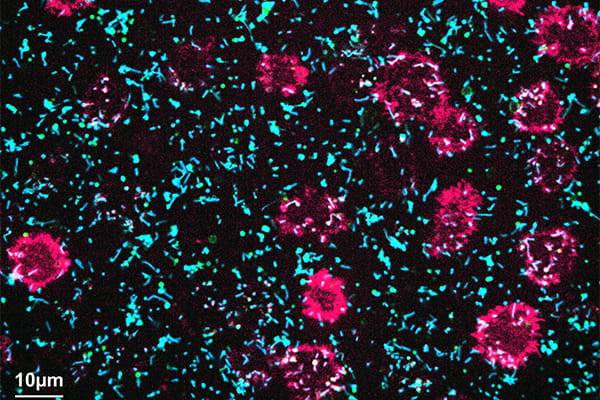Molecular activity of the immune system to get a closer look
Michael Vahey receives NSF CAREER award to study how immune system responds to viruses, vaccines

The COVID-19 pandemic brought immune systems into new light as researchers worldwide worked quickly to learn about the virus and develop effective vaccines. However, much remains unknown about how proteins in the immune system assemble and engage in response to a viral invasion.
Michael Vahey, assistant professor of biomedical engineering in the McKelvey School of Engineering at Washington University in St. Louis, has received a five-year, $606,563 CAREER award from the National Science Foundation to establish the factors that drive the assembly of viral immune complexes and study how they interact with immune cell receptors. The NSF CAREER awards support junior faculty who model the role of teacher-scholar through outstanding research, excellence in education and the integration of education and research within the context of the mission of their organization. One-third of current McKelvey Engineering faculty have received the award.
Vahey, who develops methods to study infectious diseases, seeks to better understand how the immune system recognizes foreign objects, such as a virus or bacteria, and produces antibodies that protect from infection. He and his lab will use protein and cellular engineering, combined with fluorescence microscopy, to determine how these immune complexes form at the molecular scale, and how the features of immune complexes influence how immune cells recognize and engage with them.
When a virus enters the body, various proteins in the immune system bind to its surface, creating structures known as immune complexes. The features of these complexes instruct the immune system how to respond to the invading pathogen.
“When we mount an immune response against a virus, we produce antibodies that bind to specific sites on proteins of that virus,” Vahey said. “As antibodies start binding to these proteins, they can create large complexes through aggregation. They can also present new signals that the immune system can recognize, and they can hide some portions of the virus, preventing further recognition. One of the things we are interested in is trying to understand how the portion of a viral surface protein that an antibody binds to mediates these different processes.”
Vahey said that, within the broader community of biomedical researchers working to understand immunity and improve human health, engineers bring new tools that can help understand critical processes.
“Our work is focused on looking at how antibodies function from a biophysical perspective,” he said. “We want to understand, step by step, what’s happening to the virus or vaccine as it enters the body and as the immune system begins to recognize it. Ultimately, we want to use these insights to produce, engineer or modify vaccines to achieve a certain goal further downstream.”
With the funding, Vahey also plans to work with teachers and students in grades six through 12 to teach principles of viral immunity. Local teachers will spend a summer in Vahey’s lab to learn more about Vahey’s research and how to teach that to students. In addition, Vahey plans to have students visit his lab to work with molecular visualization software that will allow students to create molecular landscapes that will help them to better understand how viruses and vaccines work.




